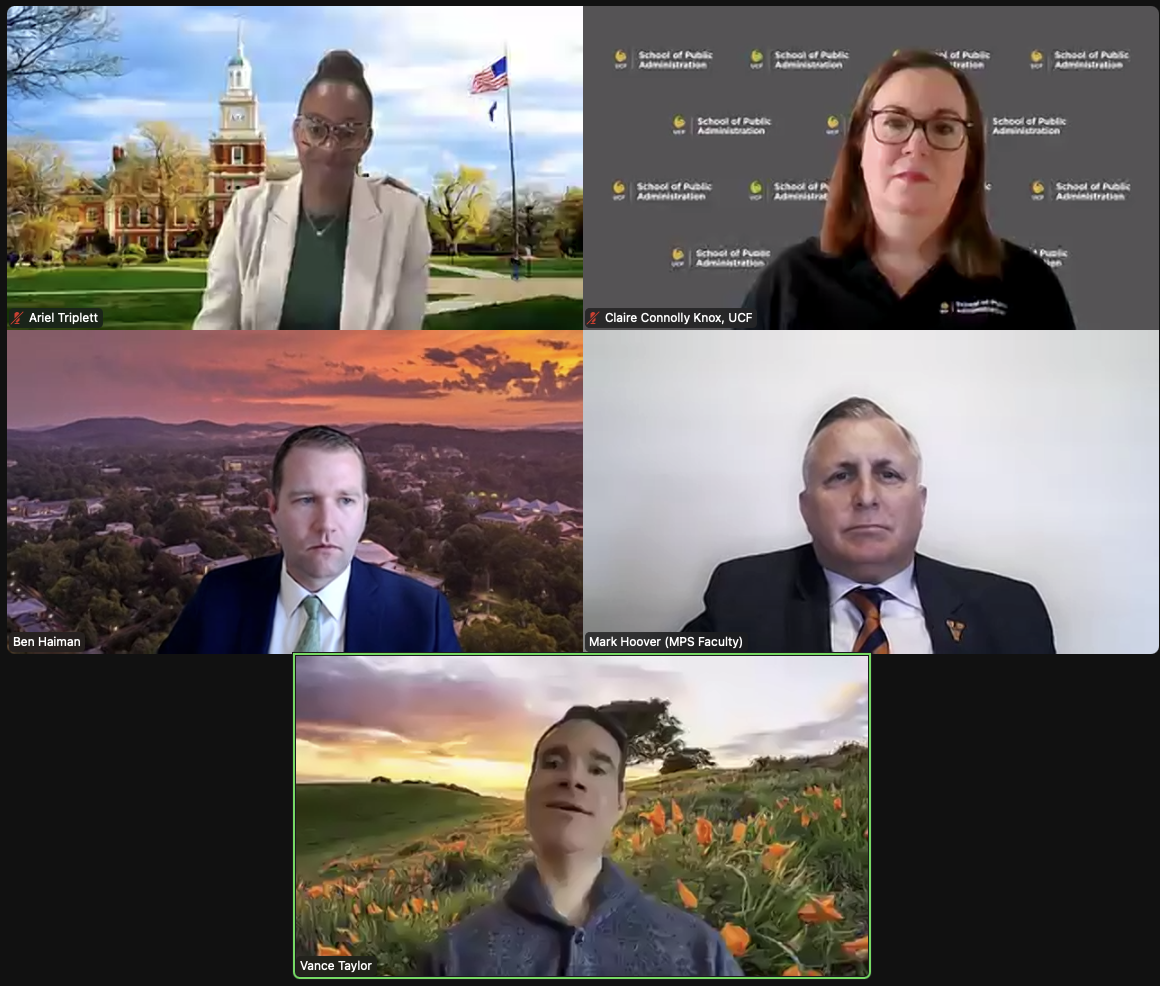Hosting discussions on disaster preparedness and response
On March 27, 2025, the UVA Center for Public Safety hosted a panel discussion on disaster preparedness and response. At the event, distinguished law enforcement and public safety experts addressed crisis management and resource allocation during natural disasters including hurricanes, tornadoes, and pandemics.
The panel was moderated by Ben Haiman, Executive Director of the Center for Public Safety and Justice, and featured the following panelists:
- Dr. Mark Hoover: Director of UVA's National Criminal Justice Command College
- Claire Connolly Knox: Program Director of the Master of Emergency and Crisis Management Program at the University of Central Florida
- L. Vance Taylor: Chief of the Office of Access and Functional Needs at the California Governor's Office of Emergency Services
- Ariel C. Triplett: Director of Emergency Management and Safety for Howard University
Expert Insights: How Leading Emergency Management Professionals Approach Disaster Response
Dr. Hoover emphasized the growing frequency and intensity of disaster events, highlighting the need for adaptability and enhanced emergency response infrastructure, especially in vulnerable areas. Hoover stated that "the adaptability and ability of our communities to keep pace is” critical for responding to these kinds of emergencies. Furthermore, he underscored the importance of interagency operability and establishing mutual aid agreements, particularly to counter “the lack of emergency response infrastructure that exists in rural or underserved communities."
From her perspective, Claire Connolly Knox examined the difficulties in implementing lessons from previous disasters. She identified insufficient capacity - financial, technical, managerial, and political - at local and state levels as a major barrier to comprehensive emergency management. taking time to "analyze after action reports, policies, plans to see how well are we actually implementing those lessons learned." She advocated for decentralizing emergency management and strengthening capabilities at local and state levels.
Ariel Triplett highlighted effective community communication; in particular, she noted the unique challenges of higher education environments with their rapid population turnover and the necessity of keeping pace with technological advancements. As Ms. Triplett explained, "Our community turns over every year, and that turnover increases with technology and add[s to] the fact that we have to stay in pace with tech and be able to communicate."
Finally, L. Vance Taylor focused on accessibility issues. Mr. Taylor stressed the necessity of providing emergency alerts in formats accessible to all community members and how, "if information is going out, but it's not going out in accessible formats, then for a lot of members of the community," they won’t be able to respond accordingly or receive key safety updates.
5 Critical Challenges Facing Modern Disaster Preparedness and Response Teams
The panelists identified several urgent challenges in disaster management:
- Escalating Disaster Frequency: The intensification of wildfires, severe weather events, and health crises requires communities to develop more agile response capabilities.
- Infrastructure Deficiencies: Many rural and underserved communities lack fundamental emergency response systems necessary for effective crisis management.
- Resource Limitations: State and local governments often struggle with insufficient financial, technical, managerial, and political resources to address all phases of emergency management.
- Communication Gaps: Coordinating effectively across community members, city departments, nonprofit organizations, and government agencies remains a significant hurdle in disaster response.
- Accessibility Barriers: Ensuring emergency information reaches all community members, including those with disabilities, continues to challenge emergency management professionals.
Breakthrough Solutions: Top Emergency Management Strategies for Effective Crisis Response
The experts recommended several approaches to overcome these challenges:
- Proactive Relationship Building: Establishing strong communication networks and partnerships before disasters strike is fundamental to successful crisis management.
- Strategic Technology Integration: Implementing advanced data analytics and communication tools can significantly enhance situational awareness and resource allocation during emergencies.
- Human-Centered Approach: Acknowledging the emotional and physical impacts on both emergency responders and affected communities leads to more effective disaster management.
- Professional Standards Development: Creating standardized qualifications and providing ongoing education for emergency management positions improves overall response quality and consistency.
Building Resilient Communities: The Future of Informed Disaster Management
The UVA Center for Public Safety panel highlighted the critical role of informed decision-making in disaster preparedness and response. By confronting key challenges and implementing innovative solutions, emergency management professionals can strengthen community resilience against natural disasters, ultimately protecting lives and safeguarding community welfare.


